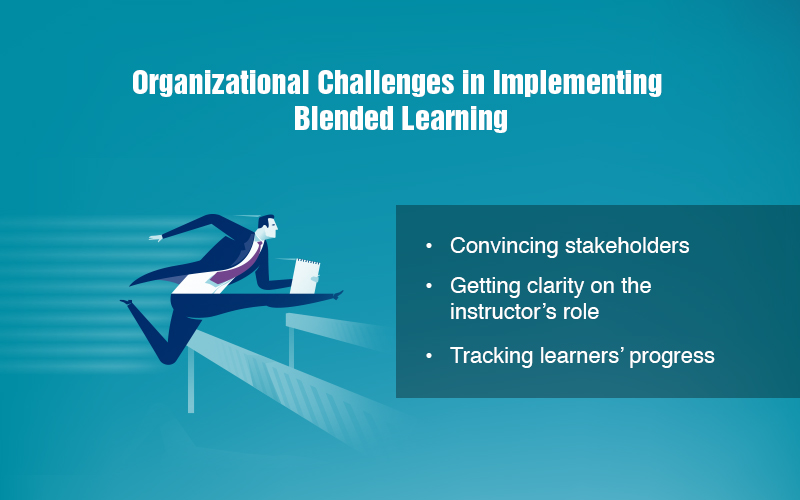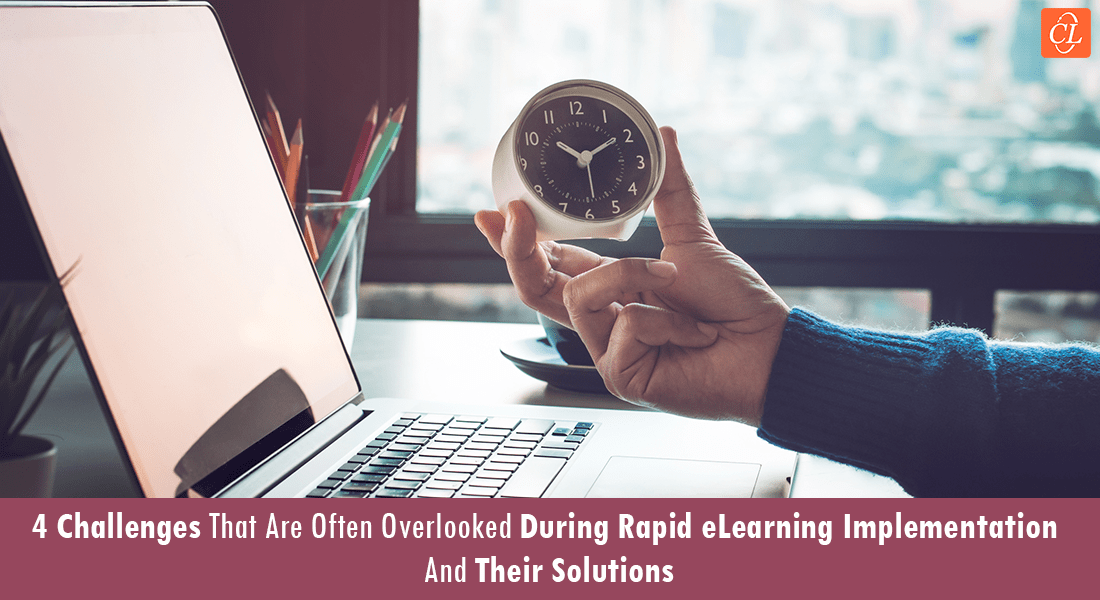9 Key Challenges of Implementing Blended Learning Programs and Ways to Mitigate Them

Burger or pizza? Noodles or momos? Ice cream or brownies? Well, how about getting to taste them all? You would love it, right? Blended learning does just that in the corporate learning and development (L&D) scenario. This learning strategy has emerged as a powerful approach, combining the best of traditional classroom methods with modern digital learning formats. The blended learning approach facilitates you to offer a mixed platter to your learners and allows them to enjoy the best of both worlds. However, its implementation comes with its own set of challenges. In this blog, we'll delve into the nine key challenges of implementing blended learning programs and explore strategies to mitigate them effectively.
Implementing Blended Learning is no Child's Play
Here are a few challenges that you might face :
Challenge #1: Getting Management’s Buy-In for Implementation
Challenge #2: Ensuring Learner Engagement and Motivation
Challenge #3: Ensuring Quality
Challenge #4: Lack of Resources
Challenge #5: Technical Challenges
Read on to discover other common challenges and proven strategies to mitigate them for successful blended learning implementation.
Basics First — What is Blended Learning?
For those who have recently ventured on their journey to the world of corporate L&D, blended learning refers to a learning strategy that combines various delivery methods to create a comprehensive and effective learning experience. It integrates traditional face-to-face classroom teaching with online resources and interactive digital tools, providing learners with a flexible and personalized learning journey.

What are the Various Learning Formats Under the Blended Learning Umbrella?
Classroom training/Instructor-led Training (ILT):
In-person instructor-led training or classroom training remains a valuable component of blended learning, offering direct interaction and personalized guidance to learners.
eLearning:
eLearning is a learning format that delivers training by using digital learning modules and resources accessible online. It forms the backbone of blended learning, enabling self-paced learning and flexibility.
Virtual Instructor-Led Training/VILT:
Similar to ILT but conducted virtually through video conferencing platforms, VILT allows for remote learning with real-time interaction. It is one of the popular training formats in today’s time as it facilitates undisrupted training for the globally dispersed workforces, keeping the human touch intact.
Microlearning:
Also known as bite-sized learning, this learning format delivers content in short modules that cater to the modern learner's preference for quick, focused learning. Videos, infographics, digital flashcards, interactive PDFs, and podcasts are a few popular microlearning formats. Microlearning is one of the hot favorites of training managers as it allows the scope to play around with various formats and make training engaging.

Social Learning Apps and Platforms:
The love of modern learners for social media has given this learning format immense prominence. Collaborative platforms, online discussion forums and communities, and social learning apps foster engagement, knowledge sharing, and peer interaction among learners. This facilitates meaningful learning, and collaboration, and boosts team spirit.
→ Shop Now: Blended Learning — A Guide to Boost Employee Performance [eBook]
What are the Common Challenges While Implementing Blended Learning Programs
Challenge #1: Getting Management’s Buy-In for Implementation
Securing support and investment from organizational leadership is crucial for the successful implementation of blended learning. However, convincing the management is not a cakewalk.
Mitigation Strategies:
- Showcase the benefits of blended learning through pilot projects and data-driven results, emphasizing cost-effectiveness and scalability.
- Create a compelling business case highlighting improved learning outcomes and ROI to gain leadership support.
- Align blended learning goals with organizational objectives and demonstrate alignment with industry trends and best practices.
Challenge #2: Ensuring Learner Engagement and Motivation
Learner engagement is a major concern when it comes to online learning. Keeping learners engaged and motivated in a blended learning environment requires interactive content, gamification elements, peer collaboration opportunities, and regular feedback mechanisms.
Mitigation Strategies:
- Incorporate interactive elements like gamification, simulations, and virtual labs to enhance engagement.
- Foster peer collaboration through group projects, discussion forums, and social learning platforms.
- Implement regular feedback mechanisms to provide personalized guidance and encouragement to learners.
Watch this video to understand how blended learning can help you cultivate a learning culture in your organization.
Challenge #3: Ensuring Quality
Maintaining high-quality content and instructional design across different learning formats is essential. Ensuring it across various learning formats under the blended learning umbrella is critical.
Mitigation Strategies:
- Conduct regular quality assessments and audits of content and instructional design.
- Gather feedback from learners and subject matter experts to identify areas for improvement.
- Keep an eye on the current trends and technologies in the corporate L&D domain. Incorporate them into your training strategy to ensure desired learning outcomes and business results.
Challenge #4: Lack of Resources
Adequate resources including technology, infrastructure, budget allocation, and skilled trainers are vital for the smooth implementation of blended learning. Falling short on any of these might result in a setback.
Mitigation Strategies:
- Invest in reliable technology infrastructure, including robust learning management systems and digital tools.
- Allocate sufficient budget for content development, training, and ongoing support.
- Provide training and professional development opportunities for trainers to build expertise in blended learning strategies.
Challenge #5: Technical Challenges
Technical issues such as poor internet connectivity, platform compatibility issues, and lack of technical skills among learners can hinder the learning experience.
Mitigation Strategies:
- Offer technical support and troubleshooting resources to address issues promptly.
- Conduct regular system checks and updates to ensure the smooth functioning of digital platforms.
- Provide training sessions and resources to enhance learners' technical skills and familiarity with digital tools.
Challenge #6: Clarity on the Trainer’s Role
This is one of the biggest challenges while implementing blended learning as the trainers might get confused or overwhelmed. In a blended learning environment, trainers may need to adapt their roles from traditional lecturers to facilitators, mentors, or coaches.
Mitigation Strategies:
- Clarify expectations and roles for trainers, emphasizing their role as facilitators, mentors, and guides.
- Provide training on blended learning pedagogy, instructional techniques, and effective use of digital tools.
- Encourage trainers to actively engage with learners, provide feedback, and support their learning journey.
Challenge #7: Aligning Online and Offline Content
Seamless integration and alignment of online and offline content is essential for a cohesive learning experience. Deciding the right mix is often a crucial challenge.
Mitigation Strategies:
- Develop a structured curriculum with clear learning objectives and seamless transitions between online and offline components. Make sure your online and offline training materials complement each other and do not end in duplication of content.
- Ensure consistency in content delivery and messaging across different formats.
- Provide easy access to resources, materials, and learning support tools for learners.
Challenge #8: Tracking Learner Progress
Monitoring and tracking learner progress, participation, and performance is vital for assessing the effectiveness of blended learning programs. Considering the multiple learning formats under the blended approach, it might be challenging to monitor learner progress and evaluate the training program.
Mitigation Strategies:
- Implement learning management systems (LMS) with robust tracking and reporting features.
- Use analytics and data-driven insights to monitor learner progress, participation, and engagement.
- Provide personalized feedback and support based on learner performance data.
Challenge #9: Evaluation and Scope of Improvement
Continuous evaluation and improvement are key aspects of successful blended learning initiatives. Sometimes, organizations find it difficult to maintain a consistent focus.
Mitigation Strategies:
- Assign a dedicated team to conduct regular evaluations, surveys, and assessments to gather feedback from learners and stakeholders.
- Analyze data to identify strengths, weaknesses, and areas for improvement in the blended learning program.
- Iterate on the learning design and delivery based on evaluation results to enhance overall effectiveness and learner satisfaction.
It’s a Wrap!
While implementing blended learning programs comes with its share of challenges, proactive planning, effective strategies, and ongoing evaluation can help mitigate these challenges and create a successful learning experience for learners. I am sure the above-discussed strategies will be handy to navigate the blended learning maze. Need more insights? Well, here’s an eBook that’ll guide you to make a confident move and boost employee and business performance.
Why wait? Grab your copy now!





